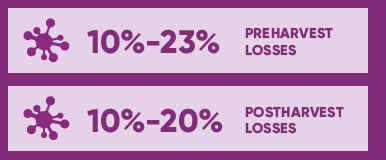Protecting Your Vineyard From the Threat of Fungicide Resistance

Every grape grower understands the challenge of controlling fungal diseases. Although fungicide applications are the most effective strategy for disease management, the rise of fungicide resistance poses a significant threat to efficacy.
Growers are often unaware they have a fungicide resistance issue until devastating diseases like botrytis bunch rot and powdery mildew have caused substantial and irreversible damage to their crops. To protect grape health and maximize yield, grape growers should consider implementing proactive strategies to address fungicide resistance.
Fungicide resistance, as defined by the Fungicide Resistance Action Committee (FRAC), is an acquired reduction in sensitivity of fungi to specific fungicides. The key challenge is the genetic variability of fungal populations, which leads to fungicide resistance in certain fungi within the population. Without a proactive approach, those resistant fungi can rapidly reproduce, causing widespread fungicide resistance across the vineyard.
Fungicide resistance poses a serious threat to growers’ bottom lines.

With studies indicating potential preharvest losses ranging from 10% to 23% and postharvest losses of 10% to 20%, the stakes are high for growers across the industry.1 Implementing a proactive plan at the beginning of the growing season can give grape growers peace of mind when diseases, such as botrytis bunch rot and powdery mildew, occur in their vineyards.
Fungicide resistance is generally not found until there is an issue in the crop, but staying alert during the growing season can help grape growers spot signs of resistance.
Avoid repeated use of fungicides from the same FRAC group, talk with neighbors about their treatment outcomes for different diseases and stay informed on resistant strains to avoid ineffective treatments.
To avoid the development of fungicide resistance, consider these best management practices:
Defending vineyards from fungicide resistance starts with informed decisions and proactive strategies. Visit Corteva.us/FungicideResistance to learn more.
1Steinberg, G., and S. J. Gurr. 2020. Fungi, fungicide discovery and global food security. https://doi.org/10.1016/j.fgb.2020.103476
Find expert insights on agronomics, crop protection, farm operations and more.